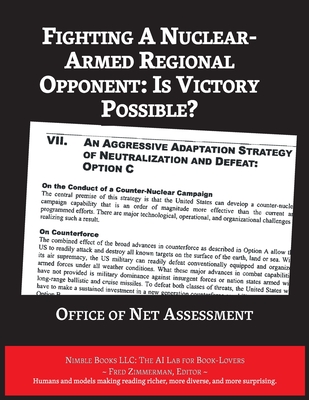Fighting A Nuclear-Armed Regional Opponent: Is Victory Possible? -

Fighting A Nuclear-Armed Regional Opponent: Is Victory Possible? -
This study, prepared by the Center for Strategic and Budgetary Assessments for the Office of Net Assessment in the Office of the Secretary of Defense, examines the increasing likelihood that the United States will face nuclear-armed regional adversaries in future conflicts and explores the implications of this likelihood for US strategy, military planning, and force structure. The report also examines how the history of nuclear proliferation suggests a new period of punctuated equilibria in which the number of states possessing nuclear weapons will increase. The study then analyzes how emerging nuclear powers may seek to take advantage of the apparent brittleness of current US strategic and operational responses to the nuclear threat, which are rooted in the binary choice between inaction and nuclear retaliation. The authors identify three basic strategic and operational responses available to the US: Option A, or the status quo, which relies on overwhelming conventional military superiority coupled to nuclear deterrence; Option B, or a Moderate Adaptation Strategy, in which the United States makes a major investment in counterforce and active/passive defense capabilities to neutralize a regional nuclear threat without recourse to a large-scale nuclear retaliatory response; and Option C, or an Aggressive Adaptation Strategy of Neutralization and Defeat, in which the United States invests in the full range of counterforce, active defense, and C4ISR capabilities to neutralize a regional nuclear threat and to prevail in a protracted regional conflict despite nuclear weapons use by the adversary.
After analyzing both the requirements and feasibility of Options B and C, the study concludes with several recommendations to prepare the US for this challenge.These recommendations
PRP: 206.58 Lei
Acesta este Pretul Recomandat de Producator. Pretul de vanzare al produsului este afisat mai jos.
175.59Lei
175.59Lei
206.58 LeiLivrare in 2-4 saptamani
Descrierea produsului
This study, prepared by the Center for Strategic and Budgetary Assessments for the Office of Net Assessment in the Office of the Secretary of Defense, examines the increasing likelihood that the United States will face nuclear-armed regional adversaries in future conflicts and explores the implications of this likelihood for US strategy, military planning, and force structure. The report also examines how the history of nuclear proliferation suggests a new period of punctuated equilibria in which the number of states possessing nuclear weapons will increase. The study then analyzes how emerging nuclear powers may seek to take advantage of the apparent brittleness of current US strategic and operational responses to the nuclear threat, which are rooted in the binary choice between inaction and nuclear retaliation. The authors identify three basic strategic and operational responses available to the US: Option A, or the status quo, which relies on overwhelming conventional military superiority coupled to nuclear deterrence; Option B, or a Moderate Adaptation Strategy, in which the United States makes a major investment in counterforce and active/passive defense capabilities to neutralize a regional nuclear threat without recourse to a large-scale nuclear retaliatory response; and Option C, or an Aggressive Adaptation Strategy of Neutralization and Defeat, in which the United States invests in the full range of counterforce, active defense, and C4ISR capabilities to neutralize a regional nuclear threat and to prevail in a protracted regional conflict despite nuclear weapons use by the adversary.
After analyzing both the requirements and feasibility of Options B and C, the study concludes with several recommendations to prepare the US for this challenge.These recommendations
Detaliile produsului









